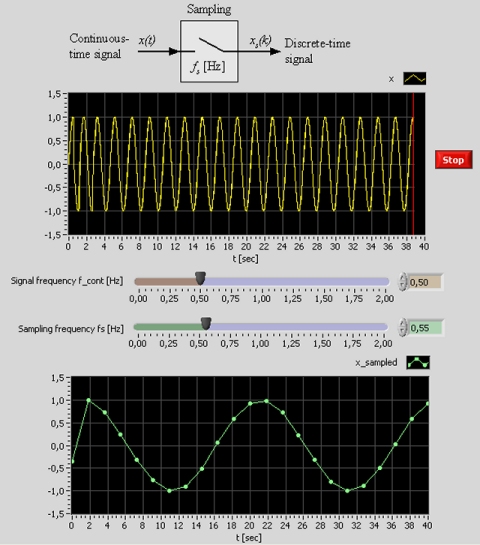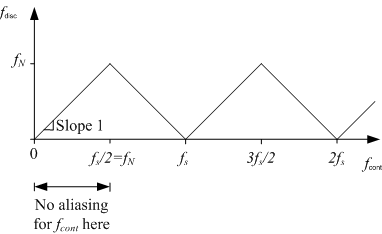Aliasing at Sampling
Snapshot of the front panel of the simulator:

- What is needed to run the the simulator? Read to get most recent information!
- Tips for using the simulator.
- The simulator: aliasing.exe . The simulator runs immediately after the download by clicking Open in the download window. Alternatively, you can first save a copy of the exe-file on any directory (folder) on your PC and then run the exe-file, which starts the simulator.
Description of the system to be simulated
Sampling of sinusoid, x(t), is simulated. The sampling results the discrete-time signal xs(k) where k is a time index (number of samples). Both signals are plotted simultaneously. You can adjust both the signal frequency and the signal frequency.
Aim
The aim is to develop an understanding of the aliasing phenomenon.
Motivation
Sampling av continuous-time signals takes place in all applications where a computer is used to read measurement data. If the sampling rate is too low compared to the frequency of the signal to be sampled, aliasing occurs. Aliasing means that the discrete-time signal gets a lower frequency than the original signal. Obviously, sampling can cause problems in applications, e.g. in audio applications.
Theory
Given a continuous-time signal, x(t), of frequency fcont [Hz] which is sampled with sampling frequency fs [Hz]. The Nyquist frequency fN is defined as half of the sampling frequency:
fN = fs/2
It ca be shown that if the signal frequency fcont is larger than fN, there is aliasing, which implies that the resulting discrete-time signal, xs, gets a frequency, fdisc, which is smaller than the signal frequency fcont. Figure 1 shows the relation between fdisc and fcont.

Figure 1
From the figure one observation is that fdisc is equal to the difference fs - fcont if fcont is between fN and fs.
Tasks
- Select fcont and fs so that
there is no aliasing (cf. Figure 1). Run the simulator.
Is it confirm that there is no aliasing?
- Select fcont and fs so that
there is aliasing (e.g. fcont =
0.5 and fs = 0.6 Hz), cf. Figure 1. Calculate from
Figure 1 the resulting frequency fdisc (of the
discrete-time signal). Run the simulator. Do you observe aliasing? If
so, what is the frequency fdisc? Is the observation in
accordance with the calculation?
- What is fdisc if fcont is equal to the Nyquist frequency? Run the simulator. Is the result confirmed?
Updated 2 September 2017. Developed by Finn Haugen. E-mail: finn@techteach.no.
